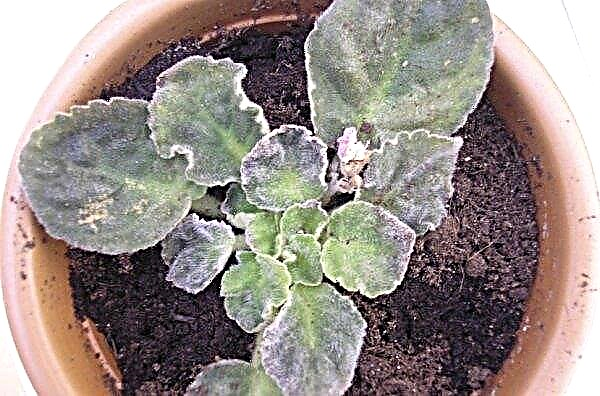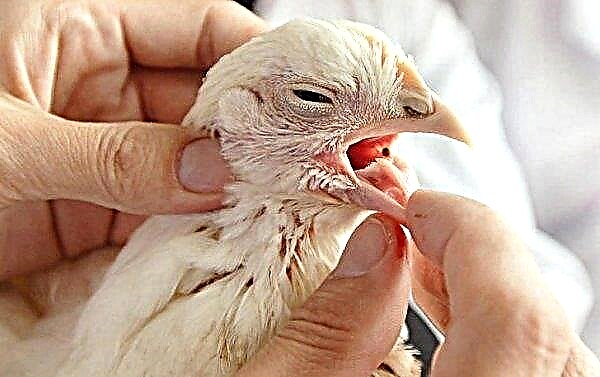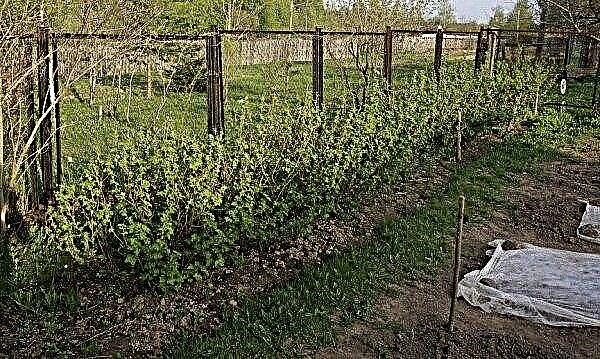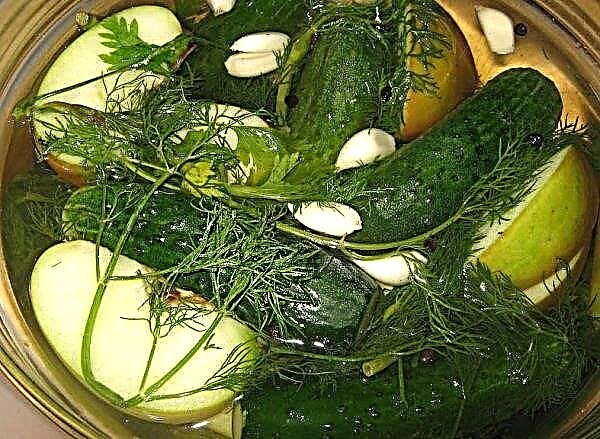Non-traditional methods of treatment are very effective, especially if they are correctly combined with standard drug therapy. Sleep in the hives (ultra-therapy or apitherapy) refers to just such varieties; therefore, it is not surprising that more and more beekeepers are interested in the features of such treatment and the independent construction of such “health resorts”. We offer you to learn about the principles of bee therapy, its benefits and the technology of manufacturing wellness apidomics with loungers for sleeping.
The principle of operation of the procedure
The principle of action of apidomics is directly related to the therapeutic effect of the procedure and is based on the following phenomena:
- When flying, each bee creates certain air vibrations, due to which it is ionized and has a beneficial effect on the human body.
- The more insects, the stronger this effect on the body, up to a barely noticeable energy massage. Such an effect will be more noticeable during sleep on a bare sunbed, since the mattress used for convenience significantly reduces vibrations (you can only use a pillow).
- Floral aromas, brought into the hive by the bees themselves, help people to relax and only contribute to their immersion in sleep.
- To calm the nervous system, the biofield of bees is also excellent, which with their presence and rhythmic buzzing can cause a feeling of peace (the sound made by insects helps to tune into meditation).
Important! For the maximum benefit of apitherapy, the duration of therapeutic sleep should be at least 1 hour. You do not need to wake the sleeping person, because the longer he sleeps, the more effective the procedure will be. True, for the maximum effectiveness of ulotherapy, it is important to undergo at least 10 sessions.
If there is no allergy to honey and other beekeeping products, then their regular use will only enhance the effect of the procedures.
Features of therapeutic sleep
Apidomics are really well suited not only for relaxing holidays, but also for the treatment of various diseases, which is easy to see by looking at the list of useful properties of ULT. However, each treatment has its advantages and disadvantages, so before you build a therapeutic hive, do not forget to consider the possible contraindications described below.

Benefit
- Sleep on beehives is aimed at treating and preventing a large number of various ailments, but, first of all, it has a beneficial effect on:
- the work of the heart and the state of the vascular system, perfectly normalizing blood pressure and eliminating any disturbances in the normal movement of blood flow (often this helps to prevent stagnant processes and the appearance of swelling);
- the functioning of the respiratory system, by cleansing the bronchi, relieving spasm and facilitating the removal of sputum (all together, these factors reduce the likelihood of developing tuberculosis)
- metabolic rate: normalizes metabolism, cleans the human body of toxins and allows you to control weight (especially true for people prone to overeating);
- reproductive system activities: bee therapy effectively eliminates anxiety caused by a malfunction of the genitourinary system, which helps to normalize its condition;
- natural aging of the body, and not only the skin, but also the musculoskeletal system (it has been proven that beekeepers are less susceptible to age-related changes);
- the body’s immune system, due to the cure of viral ailments (regular sleep in the hives perfectly eliminates the symptoms of acute respiratory viral infections and acute respiratory infections, while stimulating the production of new immune cells);
- the recovery process in the postoperative period, due to the complex effect on the body;
- prevention of cancer processes.
In addition, sleeping in the hives removes signs of fatigue and replenishes the energy loss of the body, restoring the normal functioning of the nervous system and removing the negative effects of stress and tension. The meditative buzzing of insects facilitates the transition from sleep to wakefulness.
Did you know? The bees — the most hardworking insects that fly 12 ha every day in search of raw materials for honey. Over 10 flights, one individual can collect about 200 mg of pollen.
Possible harm and contraindications
Treatment with sleep in the hives has almost all the same contraindications as the regular use of beekeeping products.
- Apitherapy will not work for you in the following conditions:
- individual intolerance to honey and other beekeeping products, which is manifested in allergic rashes, swelling, coughing or other similar symptoms;
- severe allergies to bites, accompanied by swelling and soreness of the skin at the site of contact with the bee;
- mental disorders of various origins;
- exacerbation of chronic diseases;
- a state of severe alcohol or drug intoxication.
The design of the house for sleep
Regardless of the type of construction for sleeping on hives (street or indoor), they are all made of wood, and the differences are only in the components of the structure. Usually, beekeepers choose the latter option, i.e., a full-fledged apidomic with a roof and interior decoration, which contributes to a more comfortable placement of a person.
On average, for one full-fledged house with one sunbed, you will need at least 3-4 hives, and The main structural elements in this case will be:
- thick metal base frame or foundation (best of all, prefabricated with concrete-monolithic tape screed, single-brick masonry and paving of paving slabs);
- frame support of walls and ceiling of wooden blocks (preferably 100 × 100 mm) and edged boards (50 × 100 mm);
- roof (gable);
- floor (sheet pile on wooden logs);
- ceiling (attached to the beams of the ceiling of the structure);
- sheathing (outside, you can fix the block house, inside, sheathe the room with a wooden lining, and lay a layer of mineral wool between them);
- sunbed (one or two), consisting of a side wall and a hinged battens (by pushing it away, you should have access to the hives at any time);
- hives with flyers (4 pieces of 10-11 frames each, with a magazine extension and through holes in the top cover, closed with a fine mesh).
The additional structural elements of the apidomy should include three types of boxes: door, window and manhole in the attic.
Important! When constructing a lounger between the boards, it is useful to leave small gaps through which ionized air will enter.
The street variety of apidomics is much easier to manufacture, because the main components of the structure in this case are 3-4 hives, on top of which a protective mesh is laid and a horizontal lounger with a cover is fixed. No roof is provided in this case, so you do not have to regularly ventilate the room. True, there are also disadvantages, because in bad weather apitherapy will not be very pleasant, and sometimes even impossible (for example, due to rain).
How to make a bee house for sleeping with your own hands
As you can see, a full-fledged apidomic with a roof and a comfortable lounger is much more functional than a street variety, so below we suggest that you consider the option of making such a structure yourself, starting from determining the dimensions and using drawings and ending with step-by-step instructions for assembling all parts.
Drawings and dimensioning
The size of the apidomic depends on the personal preferences of its owner, but to achieve the ultimate goal of bee therapy, a structure with an internal space of 2 × 2 m is quite enough (due to the racks, the external characteristics will be slightly larger: 2.20 × 2.20 m). The dimensions of the hives themselves in this case will correspond to 1 × 0.55 × 0.60 m (length × width × height). Such dimensions make it possible to place two bee houses between two vertical beams, thanks to which it is possible to form a solid sunbed. The drawing of the lower part of the structure and the hives in this case will look like this:

The dimensions for a bee bed are 100 × 60 × 53 cm. For the manufacture of a house frame, a wooden beam 100 × 100 mm installed on a brick foundation, or, even simpler, a metal base with legs, is ideal. It is to him that a corner (40 mm) will be welded to fix the floor and api hives. A stiffened construction will help a transversely mounted metal pipe measuring 50 × 20 mm. As a result, the floor of the structure will be at a height of 40 cm, without touching the surface of the soil.
Important! If you are not sure about the density of the earth layer and are worried about the shrinkage of the apidome, you can install the legs on concrete areas. Such a surface will be much more stable than loose soil.
A pyramidal roof, which has an attractive appearance, is ideal for sheltering the structure.
Given the dimensions of the structure, its parameters will be as follows:

It is not difficult to connect all parts of the apidome, the main thing is to prepare the necessary tools and materials, as well as adhere to the phasing of the assembly process itself.
Necessary materials and tools for work
To make an apidomic with your own hands you will need:
- wooden bars (100 × 50 and 100 × 100 mm) - 4 pcs. 2 m each and 4 pcs. 2.4 m each;
- wooden bars 40 × 40 mm (for roof lathing);
- plywood sheets - 7.5 m²;
- Decking - 7.5 m²;
- bolts for fixing 120 × 10 mm - at least 20–40 pieces;
- metal screws - 200 × 10 mm;
- construction nails;
- metal corners 4–5 mm thick - 10–20 pieces;
- boards for beehives 30 mm thick;
- grooved floor board - 4.5 m²;
- wooden lining and block house for covering the house - 10-12 m²;
- finished door and window of the selected size;
- drill;
- a machine for cutting bars or an electric saw;
- screwdriver;
- hammer;
- welding machine.
Step-by-step manufacturing instructions
The manufacture of apidomics involves several main steps:
- Welding a metal square (2 × 2 m), with a cross-shaped spacer made of metal profiles and meter, hollow square legs.
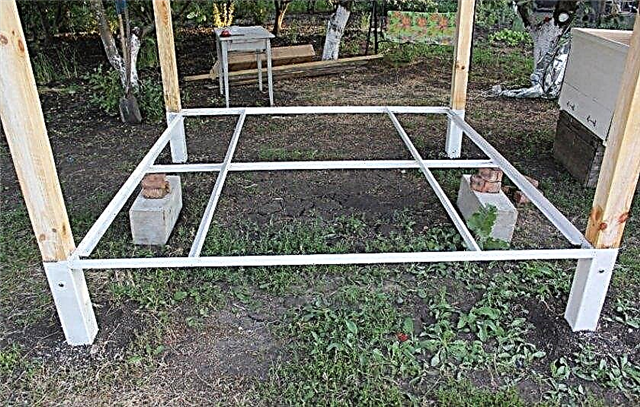
- Organization of holes around the perimeter of the square and installation of the structure on the site (the legs of the metal base should enter the ground no less than 60 cm so that 40 cm remains above the ground surface).
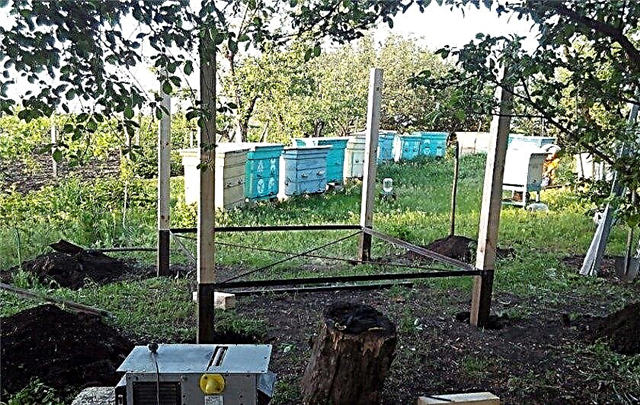
- Installation of vertical wooden supports from beams of 100 × 100 mm, and so that the lower part completely fits into the cavity of the metal legs-squares buried in the ground.
- Fastening the vertical posts with 120 × 10 mm bolts by drilling the metal part of the legs (they must connect the metal and the wood into a single whole, which will prevent a possible apidoma subsidence).

- Installation of horizontal bars in the upper part of the structure. To do this, the same wooden bars (4 pcs.) Are laid on vertical racks, but already 2.4 m long. Each of them should protrude 10 cm beyond the borders of the external contour (the bars are placed on top of each other in spikes). For reliable fixation of the structure, the horizontal elements are additionally connected to the vertical ones with the help of metal screws 200 × 10 mm.
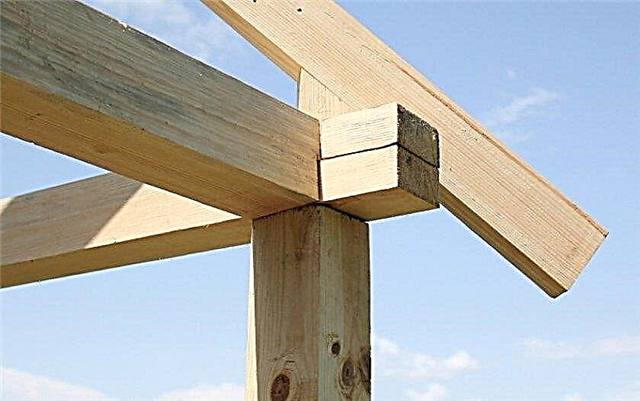
- Creating a frame base for the roof of four boards 100 × 50 mm fastened at the top with metal corners. In addition, the lower corners at the junction of inclined and horizontal wooden beams should also be taken in the same corners.

- Fastening roof battens to a wooden frame. To do this, every 60 cm to the inclined beams in a circle, wooden bars of 40 × 40 cm are attached.

- Plywood sheathing from the inside of the structure and fixing of the metal corrugated board with the outside. To fasten the material to wooden supports, metal bolts are used.
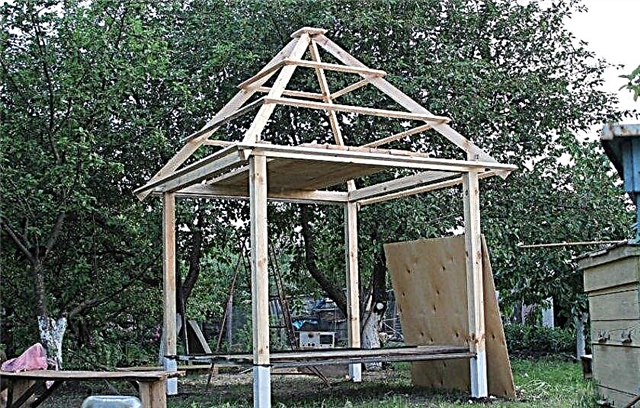
- The organization of the floor (paving is carried out from the tongue and groove board) and the installation of hives, which can be placed on one or both sides of the apidomic.
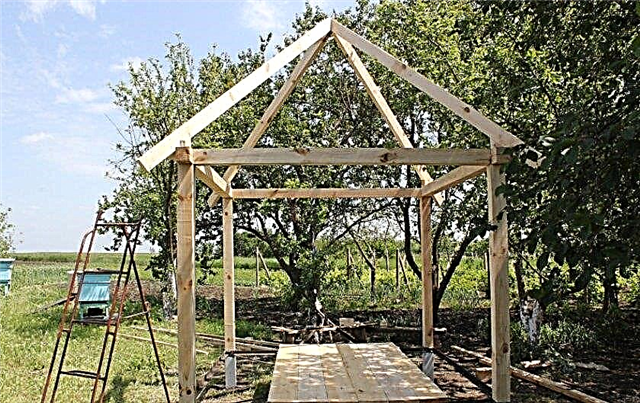
- Installation of doors and windows, lining the house with wooden lining and a block house, attaching prefabricated steps leading to the door.
- The design of the lounger using a treated wooden surface (the upper covering material of the hives must have holes with a diameter of at least 10-15 cm, “scattered” throughout the central part). Do not forget that any such holes should be covered with a fine mesh, preventing the penetration of bees inside the house.
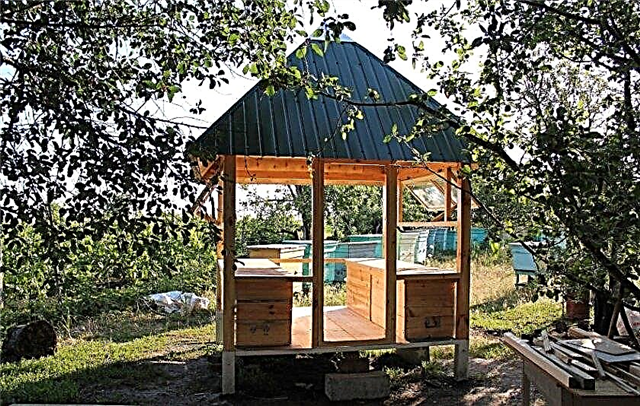
On this, the independent construction of the apidomic can be considered completed, and all that remains is to equip its internal space for greater comfort of pastime.
Did you know? Apiary of the Far East and Siberia are famous for the highest indicators for collecting nectar. For example, there are cases when during the flowering of linden the gain of the control hive in the Far East was 30–33 kg per day, and individual bee colonies in these regions brought 330–440 kg of honey per season.
Useful Tips
In the process of construction and further maintenance of apids, there are several simple requirements that must be observed for the maximum efficiency of bee therapy and the well-being of the bees themselves.
First of all, pay attention to the following recommendations:
- Under the window of the apidome, you can install a folding table, fixed to the wall with two loops. It is convenient to put personal items on it or place frames with honey while servicing hives.
- If a window is provided in the house (some structures are not sewn on all sides), then it is better to place it opposite the front door. It is good if it is bivalve, so that one part opens completely, and the second is covered with a mosquito net.
- For the manufacture of a wooden bed, a purchased wood slab 20 × 30 mm thick is best suited. It is often attached to the wall with beautiful golden loops, locking in the upper position.
- The "bed" should slightly protrude beyond the level of the hives (about 40 cm in the head area and 20 cm in the lower part), since this is the only way to avoid overheating of the body and will be comfortable even for a tall person.
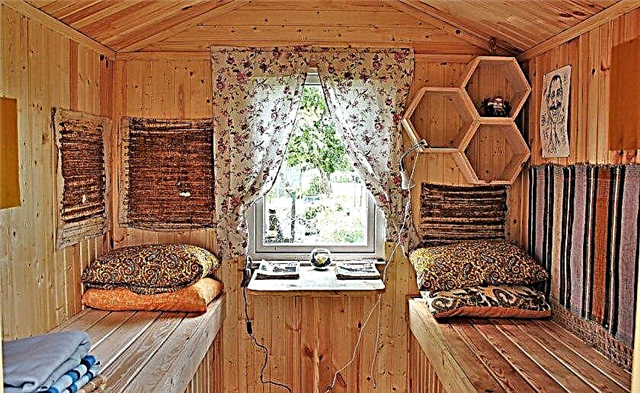
- In order for warm air to come from the sunbed, you will have to cut a large number of slots and holes in it, but not on the entire surface, but only in the central part of the bee bed. If a quarter of the entire area is allocated for them, then at least 500 pieces will be needed for 20 mm holes. For convenience, it is advisable to complete this task before installing the sunbed, away from the apiary.
- To prevent the bees from getting into the house, fine-mesh nets of metal or plastic will have to be placed on the frames, and the free space from them should be covered with wide ceilings, leaving gaps with nets installed above them.
- Do not worry if several bees get into an apid. You do not have to drive them out, just leave a small gap between the frames and lock the door at night. Insects themselves will return to the framework.
- If there are several sunbeds in the structure, then each of them needs to be serviced individually so that the bees do not contact each other.
- Wintering of bees in such an apidome requires a number of preparatory steps: removing the letlets, filling the free space between adjacent hives inside and outside the premises with hay, closing the ventilation holes in the foundation, and tightly blocking windows and doors. In such conditions, all insects can survive the cold.
Bee houses for apitherapy are a really good solution for many neurological and psychosomatic problems, and if we take into account their beneficial effect on the physiological state of a person, the increasing relevance of such structures requires no explanation. With a little effort to build such an unusual structure, you will get a real health resort, which is very pleasant to sleep in.












